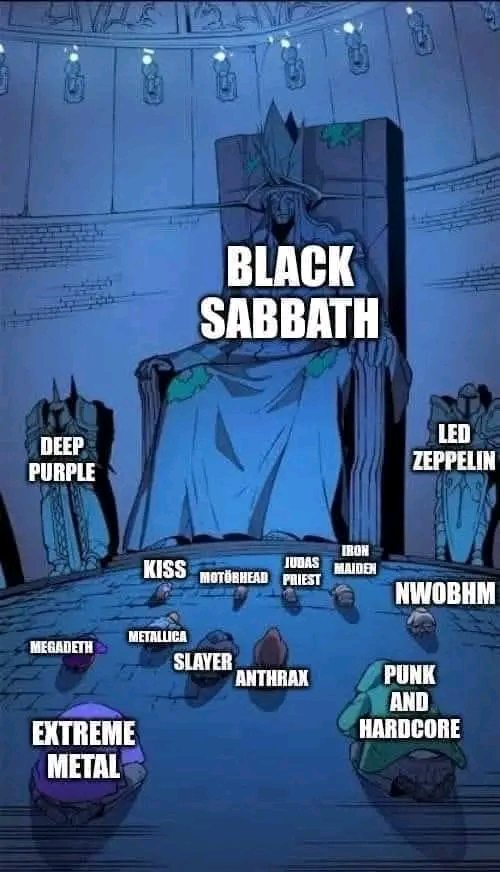Black Sabbath: The Undisputed Godfathers, Kings, and Creators of Heavy Metal — Not Hard Rock
For decades, the debate has raged within the halls of rock and metal fandom: Who truly created heavy metal? Which band stands as the definitive origin point of the genre that reshaped the music world forever?
The answer, in truth, is not even debatable to those who understand the roots of the sound.
It is, and always has been, Black Sabbath.
Not Led Zeppelin.
Not Deep Purple.
Not AC/DC.
Not Thin Lizzy or Rainbow or Scorpions or KISS or UFO.
Not punk or hardcore or any other branch of rock.
Black Sabbath is heavy metal.
Black Sabbath is the beginning and the foundation.
Black Sabbath is the godfather, the king, and the creator of the genre.
Hard Rock vs. Heavy Metal: Two Separate Circles
Many casual listeners blur the lines between hard rock and heavy metal, tossing names like Led Zeppelin, Deep Purple, and AC/DC into the same pot as Sabbath.
That’s a fundamental misunderstanding.
Hard rock bands such as Zeppelin, Purple, AC/DC, Thin Lizzy, Scorpions, and KISS focused on bluesy, upbeat, and often groove-driven sounds. Their themes were rooted in rebellion, partying, sexuality, and freedom—celebrations of life and excess.
Heavy metal, as forged by Black Sabbath, was something altogether different. Darker. Heavier. More ominous. It wasn’t just about turning the volume up; it was about conjuring atmosphere, dread, and catharsis.
Sabbath’s music wasn’t built from the blues in the way Zeppelin or Purple had done. It emerged from working-class despair in industrial Birmingham, England—a grim, soot-covered city where guitarist Tony Iommi lost the tips of his fingers working in a factory accident. That darkness wasn’t aesthetic—it was personal, forged from survival.
The Birth of Metal: February 13, 1970
The exact birth of heavy metal can be traced to the release of Black Sabbath’s debut album on Friday the 13th of February, 1970.
The opening track, simply titled “Black Sabbath,” remains perhaps the most chilling song ever recorded. It begins with the tolling of a church bell and a thunderstorm, followed by Tony Iommi’s infamous “tritone” riff—known throughout history as “The Devil’s Interval,” banned by the church in medieval times for its unsettling sound.
Ozzy Osbourne’s eerie wails, Geezer Butler’s doom-laden basslines, and Bill Ward’s pummeling drums created a sonic world that no one had heard before.
It wasn’t rock.
It wasn’t hard rock.
It was heavy metal.
And it wasn’t an accident. Sabbath knew what they were doing.
As Geezer Butler once put it:
“We were not playing blues-rock like Zeppelin or Purple. We wanted to scare people. We wanted it to sound like horror films.”
That was Sabbath’s mission—to reflect the horrors of the real world through heavy, pounding, sinister music.
The Albums That Built The Metal Empire
Their next two albums, Paranoid (1970) and Master of Reality (1971), took that vision even further.
Paranoid gave birth to metal anthems such as “Iron Man,” “War Pigs,” and the title track “Paranoid.” These were not party songs. They dealt with war, madness, and social decay.
Master of Reality introduced down-tuned guitars and thick, sludgy riffs that laid the blueprint for everything from doom metal to stoner metal decades later. Tracks like “Sweet Leaf,” “Children of the Grave,” and “Into the Void” were massive walls of sound that shattered any comparison to hard rock.
By this point, Sabbath wasn’t just influencing other bands—they were creating an entirely new genre.
The Pretenders to the Throne
Bands like Led Zeppelin and Deep Purple are undoubtedly legends—but their music was never true metal.
- Led Zeppelin delved into folk, blues, and psychedelic rock. While they were loud and heavy at times, they themselves rejected the “heavy metal” label.
- Deep Purple merged classical music and hard rock with a heavier edge but always stayed closer to the jam-heavy, blues-influenced realm of rock.
- AC/DC was and always will be rock and roll, unapologetically so, with themes of rebellion, partying, and raw energy—never the darkness of metal.
- KISS, UFO, Scorpions, Rainbow, Marillion, Meat Loaf, and others are either glam rock, progressive rock, or melodic hard rock—related but never to be confused with heavy metal’s grim essence.
Even punk and hardcore came from different cultural roots entirely—angry, fast, political, but without the crushing, doom-laden weight or guitar wizardry that defines metal.
These bands belong to another circle entirely.
Why Sabbath Reigns Supreme
Black Sabbath’s music wasn’t just about the riffs or the distortion—it was the mindset.
Themes of isolation, death, addiction, war, and existential dread became cornerstones of metal, all traced back to Sabbath’s pioneering work. Their relentless experimentation—from doom to proto-thrash—pushed music into darker, heavier, more extreme places.
Every major metal band, from Metallica to Slayer, from Iron Maiden to Pantera, bows at the altar of Sabbath.
Even modern subgenres like black metal, death metal, and doom metal owe their very existence to the eerie sounds Sabbath forged.
They didn’t just start heavy metal.
They are heavy metal.
The Final Word
Today, the debate persists largely among casual fans or marketing executives looking to simplify playlists.
But among those who know—musicians, critics, diehard metalheads—there is no debate.
Black Sabbath are not “hard rock.”
They do not share the same circle as Led Zeppelin, Deep Purple, or AC/DC.
They sit alone on the throne they built.
The Godfathers. The Kings. The Creators of Heavy Metal.
And that will never change.
